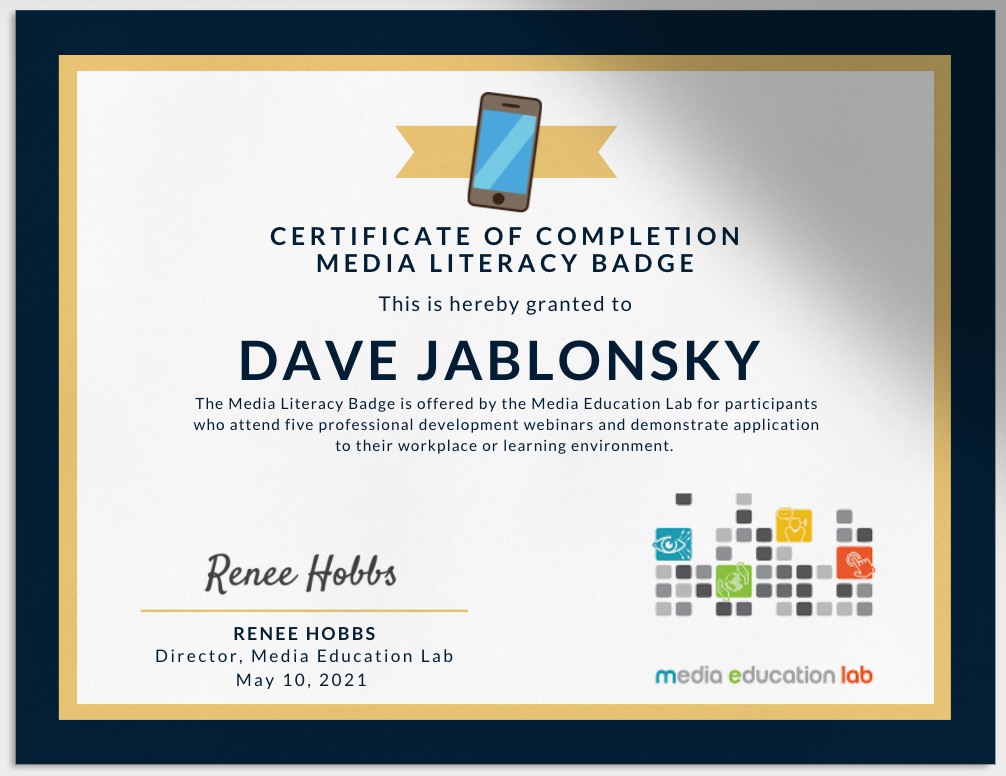Dave Jablonsky is a high school ESL, Social Studies, and Media Studies teacher on the southwest side of Chicago. He also serves as his school’s English Language Program Teacher, Student Voice Committee facilitator, and civic engagement coordinator. He is particularly interested in exploring the effects of digital media on culture, misinformation, and reading comprehension. He received his Masters in Literacy Education in 2015. As part of his continued professional development, he has taken programming on Youth and Civic Media (at UC-Riverside), KQED Teach, and the Stanford History Education Group’s Civic Online Reasoning. Dave participated in the 2020 Summer Institute in Digital Literacy as a McCormick Fellow.
A Guest Post by Dave Jablonsky

Dave Jablonsky is the first recipient of the Media Education Lab’s Media Literacy Badge.
I attended SIDL 2020 and have been enjoying your webinar series with Frank Baker this year. If I’m going to lose the battle of limiting my screentime, it’s fortunate that in part it’s at the expense of high-quality professional learning opportunities. I’ve attended each of the sessions offered this calendar year, and I’d be interested in receiving the Media Literacy Badge. Below is a brief summary of my learning and classroom applications:
The Big Game, January 11th. In this webinar, we explored means of using Super Bowl ads in the classroom. I appreciated the consideration of the purpose of advertisements and the emotional connection to specific ads. The Reese’s and Google ads especially stuck with me. In teaching my senior Media Studies class, I used Frank’s Super Bowl ad analysis sheet to allow students to reflect on 2021 ads. I used the M&M ad to model for students, but they were then able to select and analyze three additional ads of their own.
Reading the Pictures, February 10th.This presentation underscored how easy it is to adapt visuals for student learning. Some great resources shared included Michael Shaw’s Reading the Pictures website, NYTimes’ “What’s Going On in This Picture?,” and the documentary War Photographer. I have applied the four-part close image analysis (What do you 1. feel, 2. notice, 3. think, 4. interpret?) with my students.
Teaching the Capitol Siege, February 16th.I appreciated the thoughtful conversation and collaboration around the capitol siege. Similar to Reading the Pictures, we analyzed images from that tragic day. I recall participating in a spirited breakout over the Lego playset about whether it was an appropriate parody and where it originated. Having covered the insurrection for two days in January, I subsequently utilized the “Influencers and Insurrectionists” clip from the Vlog Brothers with my class.
Tournament of Value: Teaching the Oscars, March 30th. As a big movie fan and one-time Film Studies teacher, I really enjoyed this webinar. We began with looking at the language of moving images, including an activity where we applied this language to scenes from our favorite films. Then we considered representation in Hollywood (NYTimes and Jane). We concluded with a small group discussion on cultural celebrations from adolescence. I look forward to digging through Frank’s Language of Film site and plan to use the think/pair/share activity (three pieces of good news and 3 pieces of bad news). This week, we discussed Sunday night’s production and whether Chadwick Boseman was robbed of Best Actor honors.
Vaccine Propaganda, April 20th. In this most recent webinar, we looked at advertising, PSAs, and propaganda surrounding vaccinations. We discussed the relationship between each of these terms and watched several ads commenting on their effectiveness. I used quite a few (Sam Adams, the presidents, “Abuelita”) to cap off a lesson considering whether minors should need parental consent for vaccinations. Last year I had students give testimonial style PSAs via Flipgrid on COVID and safe reopening protocols. I especially appreciated the class-developed PSA on global warming. It’s inspiring to see students contribute to that level of production at such a young age. Lastly, it was nice to be reminded of the tobacco Truth ads that I grew up with as a child, which recalled the tactics of Adbusters, which gravitated towards in college.
Learn more about how you can earn your Media Literacy Badge from the Media Education Lab.

Comments(0)